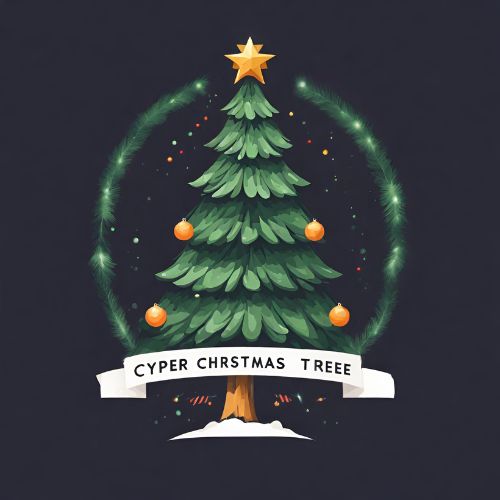You’ve been curious about flocked Christmas trees, right? Here’s the scoop: flocking a tree is simply adding a snowy look to it. Wondering if it’ll mess up your living room? It might, but I’ll show you how to do it cleanly and also how to remove the flocking if you decide against it later. Storing your flocked tree, whether real or artificial, is straightforward and I’ll walk you through that. Plus, I’ll tell you how long it’s likely to last. Need to know if it requires water or how to stop it from yellowing? Got you covered. Other concerns? We’ll address those too. And yes, your pets are safe around a flocked tree. As for style, flocked trees are definitely still in vogue. To top it off, I’ll throw in some awesome decorating tips. Let’s get started on this flocked Christmas tree journey!
What is the Significance of a Flocked Christmas Tree?
Flocked Christmas trees, with their snow-dusted branches, are a sight to behold. They mimic a tree freshly kissed by snowfall. The magic lies in the ‘flocking’, a snowy coating that’s been sprucing up trees since the 1800s. Flocking is a concoction made from stuff like cornstarch, cotton, glue, flour, or even soap shavings. Today, you can either buy a pre-flocked tree or get your hands dirty with a flocking spray. While DIY flocking is fun, pre-flocked trees win points for their durability and lower maintenance. Either way, flocking transforms your Christmas tree into a snowy spectacle, taking your holiday decor up a notch.
Read more: cyber Monday Christmas tree sale
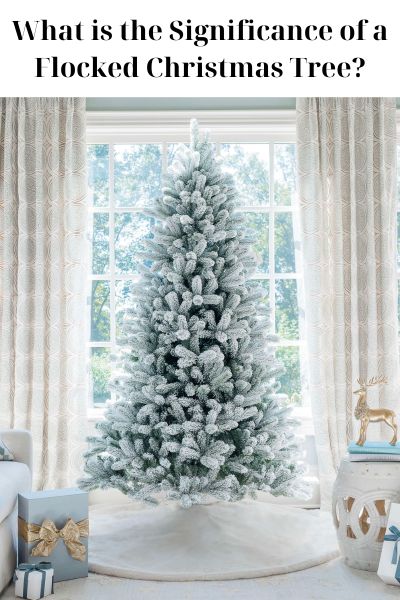
What is the methodology of flocking a Christmas tree?
Flocking a Christmas tree means giving it a snowy makeover with synthetic fibers. You mix the flock, which are these tiny fibers, with adhesive, and then spray it all over your tree using compressed air. It’s a bit like dusting your cake with powdered sugar! Once you’ve got an even coating, you let it dry and shake off any extra flock. It’s a pretty popular method these days because everyone loves how it makes their tree look like it’s straight out of a winter fairy tale.
How can I personally apply flocking to my Christmas tree?
Flocking your Christmas tree is a DIY project you can totally tackle. It’s about spritzing, brushing, or sticking on a white, powdery substance to mimic snow on your tree. There are tree flocking kits out there that make this process a breeze. All set to try it out? Dive into our step-by-step guide on how to flock your own Christmas tree and let your imagination run wild. Looking for some decorating ideas? Browse our array of Christmas tree styles to get in the holiday spirit.
Will a flocked Christmas tree create any mess in my home?
Pre-flocked Christmas trees are a neat choice, thanks to professional flocking and sealing. You might notice some shedding while setting up or lighting the tree, but it’s usually fuss-free. But if you’re going for DIY flocking, brace yourself for some mess. Flocking tends to drop off over time, especially with heavy handling. So, pick a roomy spot like your garage or patio for the flocking job, and have a vacuum ready to clean up the fallen flocking. A tarp or dropcloth under the tree can catch any shedding or residue too. All in all, pre-frocked trees are less messy than DIY ones, and they stay in good shape with the right care and storage.
How can I eliminate the flocking from my tree?
Getting rid of flocking from your tree is pretty straightforward. Start by spreading out a dropcloth to catch the falling “snow”. Make sure the tree is bare, no ornaments or lights left. Give your tree a good shake to let loose as much flocking as you can. Next, grab your vacuum with a bristle brush or upholstery attachment to suck up the rest of the flocking. Brush along the direction of the pine needles to avoid any damage. If you want to speed things up, a rag with some water or acetone could do the trick. If you use acetone, make sure to wipe down the tree again with a damp rag to get rid of leftover acetone. Just ensure you’re in a well-aired space and put on a mask if necessary.
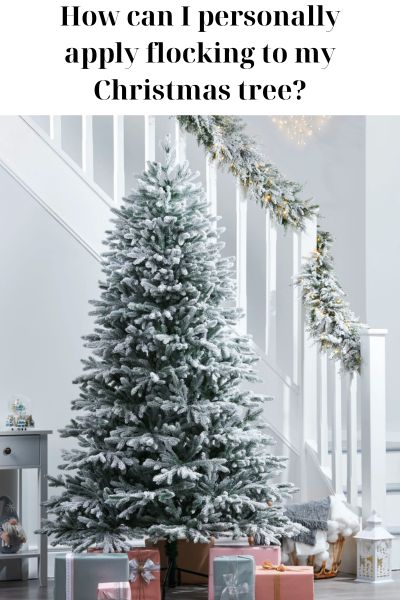
What is the optimal method for storing my flocked Christmas tree?
The ideal way to store your flocked Christmas tree is upright. Laying it down could lead to flocking loss. To keep the flocking intact, wrap the tree standing up in plastic or put it in a storage bag designed for trees, and stash it in a cool, dry spot.
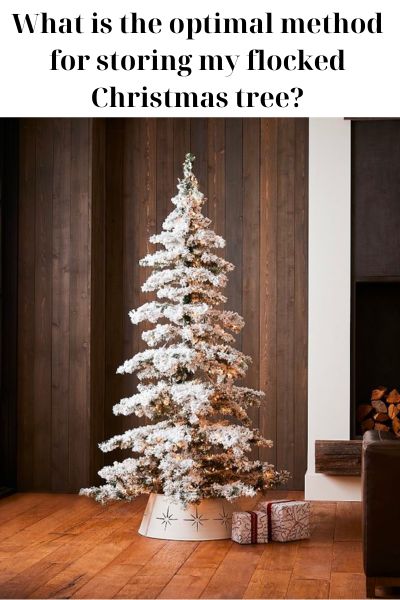
What is the lifespan of my flocked artificial Christmas tree?
Your flocked artificial Christmas tree’s lifespan can vary based on the manufacturer, but with good care, it can serve you for many years. Some flocked tree brands even provide up to a decade of warranty. Proper storage in a cool, dry area during non-festive seasons can extend its life even more. If you’ve flocked the tree yourself and used top-notch supplies, it should still last a good while, provided you handle and store it carefully. And if some “snow” sheds off, don’t fret – you can always re-flock your tree.
What about the longevity of a real flocked Christmas tree?
The lifespan of a real flocked Christmas tree tends to be about two to four weeks.
Is it necessary to water my real flocked Christmas tree?
While your real flocked Christmas tree retains moisture thanks to the flocking, it’s not a must to water it. But if you choose to, it could be beneficial.
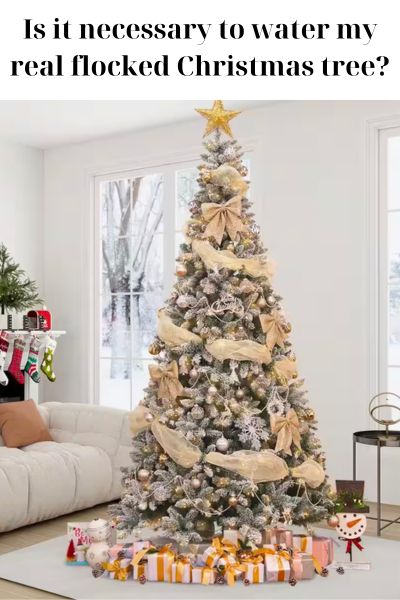
Any suggestions on preventing my flocked tree from discoloration?
Your flocked tree might start to yellow due to light exposure and high humidity over time. To prevent this:
Clean your tree carefully with a feather duster or clean cloth after taking off the lights and ornaments.
Use gift tissue paper to wrap the branch tips before tucking the tree into its storage bag.
Store your tree in a spot that’s cool, dry, and out of direct sunlight to avoid water damage.
What are some common queries regarding flocked Christmas trees that I should be aware of?
Is a flocked tree harmless for my pets?
If you have pets, a flocked tree might not be the safest option. The flocking materials can be harmful if eaten, and pets, being naturally curious, might try to nibble on them. Even real trees can be risky, particularly for cats, due to the toxicity of pine needles and the water used for the tree. So, if you’re a pet owner, an artificial, non-flocked tree could be a wiser choice.
Do flocked Christmas trees maintain their popularity?
Flocked Christmas trees have remained a beloved choice since the mid-1900s. Their unique charm that brings a winter wonderland vibe indoors continues to win hearts, so they’re likely to stay popular for years to come.
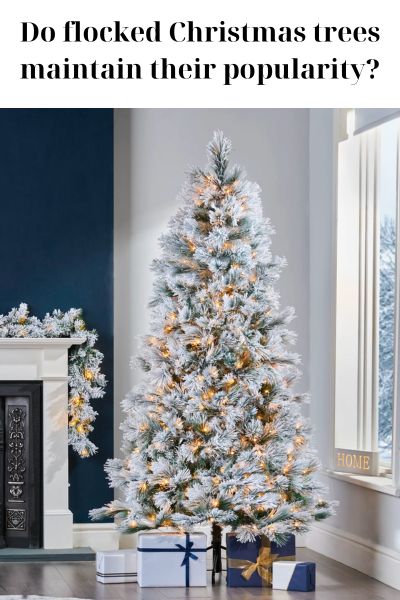
What are some unique flocked Christmas ornaments and accessories?
There’s an array of unique flocked Christmas ornaments and accessories you can use to amplify the snowy vibe of your tree. Battery-operated string lights, for instance, can add a cozy warmth. Snowflake ornaments and white or silver ribbon also make great options. Don’t forget about flocked wreaths and garlands to tie everything together. And for that final touch, go for a snowman or snowflake tree topper.
What are the various types of flocking materials utilized on Christmas trees?
There are many types of flocking materials that can be used on Christmas trees. Some of these materials include cellulosic fibers in powder form, synthetic fibers, foam, and shredded paper. Each of these materials can create a unique texture and appearance on the tree. Some people prefer a more natural look with cellulosic fibers, while others may opt for synthetic fibers for a brighter, more vibrant appearance. Foam and shredded paper can also add a unique texture to the tree, giving it a more rustic or vintage look. Regardless of the material chosen, flocking can add an extra dimension of beauty and sophistication to any Christmas tree.
Is the practice of flocking eco-friendly?
In my opinion, flocking can be an eco-friendly practice if done correctly. Recycled paper, which is a cellulose-based material, can be used to make flocking more sustainable. This can reduce the number of times artificial trees need to be replaced, which is an environmental benefit. Overall, flocking can potentially be a sustainable and responsible choice for those who want to decorate trees.
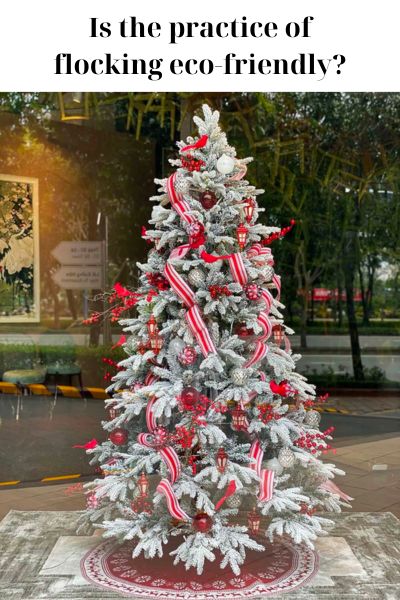
Could flocking potentially cause health issues?
As someone who has worked with flocking materials, I know that some synthetic materials may release volatile organic compounds (VOCs) into the air, which can cause respiratory irritation. So, yes, flocking has the potential to cause health issues if proper precautions are not taken. It’s important to make sure you’re working in a well-ventilated area and to choose materials that meet safety standards. Be aware of the potential risks and take steps to protect yourself from any harmful effects of flocking.
Are there any other alternative flocking methods?
Well, I’ve heard of a few alternative ways to create the look of flocking on a Christmas tree. Some folks make their own flocking mixture with water and soap flakes, or use spray-on snow instead of flocking powder. However, these DIY methods might not produce the same level of texture as the traditional flocking process.

Hi, I’m Eugene B. Conley – the CEO of cybermondaychristmastree.com. I was born on December 13, 2000, and I’m a proud Sagittarius. I currently live at 3524 Reeves Street in Green Bay, WI 54301.
Before becoming the CEO of cybermondaychristmastree, I worked as a Meter Reader at The Pink Pig Tavern. While I enjoyed my time there, I had a passion for e-commerce and technology. I decided to pursue my dreams and started my own online venture.
At cybermondaychristmastree, we offer the best deals on Christmas trees during the Black Friday season, from Amazon to Walmart and many more. We help customers find the perfect tree for their homes at the most affordable prices, while also making their holiday shopping experience seamless.
Thank you for taking the time to read about me and my journey at Cyber Monday. I am committed to providing excellent service and quality products to all our customers.
